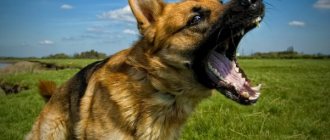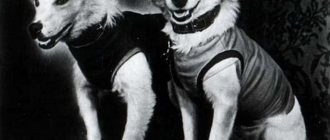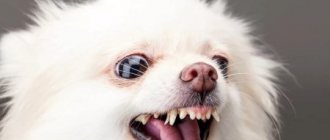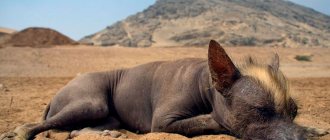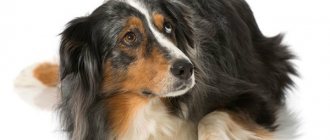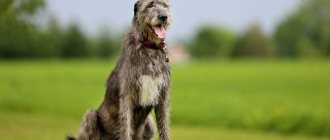History of the Origin of the Basenji
Basenji is one of the oldest breeds. Similar dogs have been found in Egyptian burials that are more than 6,000 years old. There were two of these in Tutankhamun's tomb, embalmed, wrapped in expensive fabrics and with collars of precious stones. They probably had enormous cultural significance. Also, household items, figurines, and wall paintings indicate ancient origin. With the fall of civilization, the Basenji fell into oblivion in North Africa, but survived in the central regions of the continent. They were highly valued by the natives for their hunting qualities, speed, extraordinary intelligence and silence. They were even credited with magical properties: the ability to restore the aura and take away negative energy.
It is interesting that today you can find free-living Basenjis in the African jungle. These are half wild dogs that are quite capable of getting their own food. In the wild they gather in small flocks.
In 1905, several Basenji dogs were brought to England. However, the attempt to introduce the world to these amazing creatures was not successful. The dogs did not survive the months-long journey well and soon died. The official debut of the breed was in 1937, when the Basenji were exhibited at the Craft Show under the name Congo Terrier.
African pygmies call the Basenji a bush dog and are still used for hunting, including lions.
Basenjis appeared in Russia in 1997. The modern livestock is small in number, but of a fairly high level and can compete at international exhibitions.
History of the breed
The Basenji is included in the list of the 14 most ancient dog breeds on earth and the history of the breed goes back about 5,000 years. Endurance, compactness, strength, speed and silence made it a valuable hunting dog for African tribes.
They used them to track, pursue, and guide the beast. For thousands of years they remained a primitive breed, their color, size, body shape and character not controlled by man.
However, these qualities did not save the weaker representatives of the breed from death during a dangerous hunt and only the best survived. And today they live in the pygmy tribes (one of the oldest cultures in Africa), almost the same as they lived thousands of years ago. They are so valuable that they are worth more than a wife, have equal rights with the owner and often sleep inside the house while the owners sleep outside.
Edward C. Ash, in his book “Dogs and Their Development,” published in 1682, described a Basenji he saw while traveling in the Congo. Other travelers also mentioned it, but the full description was compiled in 1862 when Dr. Dr. George Schweinfurth, traveling in Central Africa, met them in a pygmy tribe.
Initial attempts to breed were unsuccessful. They first came to Europe via England in 1895 and were introduced at the Crufts' Show as the Congo Bush Dog or Congo Terrier. These dogs died of distemper shortly after the show. The next attempt was made in 1923 by Lady Helen Nutting.
She lived in Khartoum, the capital of Sudan, and was intrigued by the small Zande dogs she often encountered during her travels. Having learned about this, Major L.N. Brown (LN Brown), gave Lady Nutting six puppies.
These puppies were purchased from different peoples living in the Bahr el Ghazal region, one of the most remote and inaccessible parts of Central Africa.
Deciding to return to England, she took the dogs with her. They were placed in a large box, secured on the upper deck and set off on a long journey. This was in March 1923, and although the weather was cold and windy, the Basenji endured it well. After arriving they were quarantined and showed no signs of illness, but after vaccination they all fell ill and died.
It wasn't until 1936 that Mrs. Olivia Burn became the first breeder in Europe to breed Basenjis. She introduced the litter to the Crufts' Dog Show in 1937 and the breed became a hit.
She also wrote an article, “The Barking Dogs of the Congo,” which was published in a newspaper published by the American Kennel Club. In 1939, the first club was created - “The Basenji Club of Great Britain”.
The breed appeared in America thanks to the efforts of Henry Trefflich in 1941. He imported a white male named 'Kindu' (AKC number A984201) and a red female named 'Kasenyi' (AKC number A984200); these and four more dogs that he would bring later would become the ancestors of virtually all dogs living in the United States. This year will also be the first in which they have been successfully bred.
The unofficial debut in the United States took place 4 months earlier, on April 5, 1941. A little girl, later nicknamed Congo, was discovered in the hold of a cargo ship carrying goods from West Africa.
A very emaciated dog was found among a cargo of cocoa beans after a three-week journey from Free Town to Boston. Here is an excerpt from an article published April 9 in the Boston Post:
On April 5, a cargo ship from Freetown, Sierra Leone, arrived at the port of Boston with a cargo of cocoa beans. But when the hold was opened, there were more than just beans. A female Basenji was found in an extremely emaciated state after a three-week trek from Africa. According to crew reports, as they loaded cargo in Monovia, two non-barking dogs were playing near the ship. The crew thought that they had escaped, but apparently one of them hid in the hold and was unable to get out until the end of the voyage. She survived thanks to the condensation that she licked from the walls and the beans that she chewed.
The Second World War interrupted the development of the breed both in Europe and the USA. After its completion, Veronica Tudor-Williams helped give impetus to development; she brought dogs from Sudan in order to renew the blood. She described her adventures in two books: Fula—Basenji from the Jungle and Basenjis, the Barkless Dog. It is the materials of these books that serve as a source of knowledge about the formation of this breed.
The breed was recognized by the AKC in 1944, during which time the Basenji Club of America (BCOA) was established. In 1987 and 1988, John Curby, an American, organized a trip to Africa, the purpose of which was to obtain new dogs to strengthen the gene pool. The group returned with brindle, red and calico dogs.
Until that time, the brindle-colored Basenji was not known outside of Africa. In 1990, at the request of the Basenji Club, the AKC opened a stud book for these dogs. In 2010, another expedition was undertaken with the same purpose.
The breed's history has been tortuous and complicated, but today they are ranked 89th in popularity among all 167 breeds in the AKC.
Appearance
The Basenji is an elegant, short-haired, thin-boned dog. The head with erect ears and wrinkles proudly rides on a well arched neck. The tail is curled into a tight ring, the chest smoothly merges into a well-defined waist.
- Height at withers - 40-43 cm.
- Weight - 11-17 kg.
The skull is flat, of medium width, tapering towards the nose. Numerous fine wrinkles form on the head during excitement. The jaws are strong with a perfect scissor bite. The eyes are almond-shaped, dark, set obliquely, looking into the distance. The expression is a bit mysterious. The ears are erect, small, and fine in texture. The neck is of good length, strong, with a noticeable scruff, well set on the shoulders. Provides a proud posture to the head.
The lack of barking has nothing to do with the vocal cords. Basenjis have them in perfect order and help make a wide variety of sounds: snorting, giggling, growling, groaning, muttering and a kind of howling.
The back is horizontal, short. The loin is short. The tail is set high, close to the spine, and curled into a single or double curl. The chest is deep, rising to a pronounced waist. The forelimbs are dry, thin-boned, and muscular. The feet are small, compact, with deep pads and short nails.
The coat is short, thick, and lies tightly to the body. There is no undercoat. Colors:
- Black and white;
- Red and white;
- Brindle (black clear stripes on red);
- Tri-color: black and white with tan markings the color of melon seeds.
In warm climates, the Basenji's coat is silky and coppery. In cold weather it becomes rougher, but does not lose its shine.
Character and behavior
The Basenji has a complex, but at the same time very interesting character. Many compare them to cats because of their “mannered” behavior, curiosity, sharp mind and stubbornness. These are mischievous, active dogs with a strong sense of humor. They are interested in absolutely everything that happens around them and they have their own opinion on everything. Basenjis are very reserved and independent.
They really don’t know how to bark, but they are not shy in expressing their feelings and accompany many of their actions with other sounds. They can growl loudly, squeal, groan, snort, howl. It is believed that Basenjis once knew how to bark, but humans taught them to “quiet” hunting, where dog barking was unnecessary. By the way, the howls of Basenjis and singing New Guinea dogs are very similar. No other breed of dog can boast of the ability to sing like that.
In the house, the Basenji considers himself a full-fledged member of the family, defends his rights, and demands attention and time. Gets along well with cats, especially when growing up together. However, you should not keep smaller pets, such as birds, ferrets, hamsters, guinea pigs or rats, as the hunting instinct may take over. Basenjis are often aggressive towards other dogs, regardless of their size or gender. This behavior is genetic and is rather ritualistic. The Basenji has no desire to harm his opponent, only to prove his superiority or rightness.
Those who want to get a Basenji should be ready to forgive the dog's pranks and understand its essence, in which independence, cunning and energy prevail.
The Basenji is very affectionate and gentle with his owner and his family members. He is strongly attached to all family members. He prefers to sleep on his feet, or even on his hands. Gets along well with children. Basenjis are playful, but they can hardly be called friends for a child. The puppy often has to show that a human baby is not a game that needs to be chased and bitten. In games, the Basenji mostly runs in circles or runs away, does not fetch the shelf and does not listen to commands. Therefore, children are not very interested in playing with him.
The Basenji does not have a guard instinct and is absolutely not aggressive towards people. Friendly, indifferent or cautious with strangers. Some dogs are very friendly towards everyone around them.
Caring for the Basenji
Basenjis are very energetic dogs and require daily physical and emotional stimulation. Therefore, it is necessary to take a long walk with the Basenji and be sure to play. It is advisable to be able to walk in large open and safe spaces. Grooming is minimal, consisting only of periodic combing of dead fur.
She can live in any space, she does not need separate “mansions” to feel comfortable, because she is very small, slightly larger than a cat, her height is a maximum of forty-three centimeters, and her weight is even ten or eleven kilograms.
This is a wonderful friend and a reliable guard, although he is overly friendly, but still he will never let a stranger into the house without the owner’s permission. All dogs of this breed are overly playful and affectionate, they love walks in the fresh air and endless space.
This dog should not be left alone, because, bored, the Basenji can chew on everything that comes in its way. When walking, you need to carefully monitor your pet, because Basenjis love to run away, and it is simply impossible to catch them.
Education and training
You can hear and read a lot about the stubbornness and uncontrollability of Basenjis, that they do not know how to obey, and are very strong-willed and independent animals. To some extent this is true. Independence is the core that has helped them survive in the wild for thousands of years. Nevertheless, Basenjis are very smart and amenable to training; they pick up everything on the fly and quickly remember commands. Single specimens are even used in agility competitions, which indicates a high level of contact.
This breed is not for beginners. The owner of a Basenji must have experience in keeping and raising dogs, and be an energetic, calm and patient person.
At home, these dogs are attentive and listen to their owner. They always try to be nearby. On the street, instincts take over and Basenjis often become uncontrollable. It is very difficult to motivate them even with their favorite treats, if something in the environment is more interesting for them. You need to train your Basenji constantly, otherwise the dog begins to get lazy and stops fulfilling the simplest requests.
Basenji training
Training implies mutual understanding between the owner and the dog. There is no beginning and no end to this process. Training occurs throughout the dog's life, the main thing is to find a common language. Everyone has a certain image of a dog in their head, a model of its behavior, and based on this stereotype you build this communication. The most important thing is to establish a trusting relationship and understand how your dog perceives you.
We advise you to read: Weimaraner Dog Breed
This is a very active dog breed that needs intense exercise. The Basenji makes an excellent pet, but can also show disdain for training, which is similar to a cat. Like a cat, he is also clean and does not emit any foreign odors. Despite all the positive qualities of this breed, we should not forget that this is a hunting dog.
Basenjis are not suitable for “conventional” training. They should not be punished physically. Classes should, first of all, interest the dog. And once interested, only positive reinforcement is used to practice the command. Clicker training is ideal and is interesting for both the dog and the owners. So, if you have practiced raising servants, this dog will not suit you.
Think about what kind of pet you want before you start training. Basenji dogs exist on their own. That is, they decide for themselves when to go for a walk, where to go, and when to return. A breed of dog like the Basenji is sometimes much more interesting to walk alone than to walk on a leash with its owner next to it. However, you should determine for yourself where and how to walk your dog, even if he is pulling the leash in the opposite direction. Encourage good behavior of the Basenji and stop attempts to disobey you. By controlling your dog's desires, you control its behavior.
Train your Basenji, but never treat her harshly or expect complete obedience from her. If raised incorrectly, the dog becomes uncontrollable. The Basenji needs to throw out all the accumulated energy. If you do not provide your dog with long walks and active games, then expect a protest. She can cause you a lot of trouble while in the apartment.
The root of most dog behavior problems is that they don't use their energy enough, keep your dog busy with games, let him run around, socialize. If your dog spends enough time walking, he won't be a nuisance at home.
There is a lot of information about the uncontrollability of the Basenji, about the Basenji who destroyed the house. Have you ever wondered why such information appears, maybe the dog is bored, maybe it is protesting against a bad attitude. Maybe she hasn't used up her energy and needs to occupy herself with something. Think about it and maybe everything will fall into place. By working with the dog, giving it commands, making it habitual for it, you make its life richer, more interesting and more comfortable.
Features of Basenji content
The African dog is not suitable for year-round living on the street in the climate of the middle zone, but is excellent for keeping in a private house or apartment. She loves comfort and gets it by any means. At home, she should have her own corner with a bed and toys, where she can retire and relax. Basenjis do not smell, even when their fur gets wet.
Seasonal shedding is moderate, the rest of the time it is weak. The wool is short and quite tough; if not taken care of, it clings to furniture upholstery and clothing.
It should be mentioned that these dogs simply cannot stand rain and cold. They would rather agree to go for a walk when it is -10°C outside than stick their face out into the street in rainy weather. This does not apply to swimming. Most Basenjis tolerate water treatments calmly and love to swim in bodies of water in the summer, especially if there are ducks or other animals there to hunt.
It is difficult to find a Basenji owner who has not encountered the problem of damaged things. This dog agrees to chew anything: from socks and shoes to phones and TV.
For many owners, the only option is a home aviary or cage. It will protect the dog from troubles, for example, electric shock when the cords are damaged, and things from a curious nose and sharp teeth.
Basenjis are social and do not tolerate prolonged loneliness. This dog should not be owned by people who are busy at work for a long time and are not ready to devote time to long walks.
The owners joke that this dog can’t walk. Normal calm Basenji walks are not suitable. These dogs need to be walked a lot and actively, to tax their brain and sense of smell, otherwise they will start looking for “entertainment” at home, gnawing something, howling and whining.
Basenjis love to pick up from the ground and have a difficult time weaning themselves from this habit; they are prone to escape and are difficult to handle outdoors. They only join the team if they deem it necessary. Males can be pugnacious, and the size of their opponent doesn’t really matter to them. Without looking back they run out onto the roadway. Many owners walk Basenjis exclusively on a leash, but unless they run or ride a bike, the dog will not be able to get proper exercise. It was noticed that more often the dog shows aggression towards its relatives when walking on a leash. When running in the field, Basenjis mainly follow the owner and are within sight. However, not everyone behaves this way. To be on the safe side, some owners put a collar with a GPS tracker on their pets. When the air temperature drops below +5-10°C, the dog is warmed according to the weather.
For calm people, walking a Basenji is difficult and uninteresting. It can only be started by a person with nerves of steel, a lot of free time and the presence of a running field near the house.
Care
Basenjis are naturally very clean. They even wash themselves like cats. There is never any foreign smell from them. Moreover, many Basenji owners claim that they are the purest dog breeds. The coat should be cleaned once a week using a brush. This will keep shedding to a minimum. You don't have to bathe your dog often. Ears are cleaned as needed. Brushing your teeth is recommended once a week, but often needs to be replaced with toys and treats from the dental series. Claws are trimmed as they grow.
Nutrition
The Basenji's diet should include a complete list of vitamins, proteins, carbohydrates and minerals that are necessary for its health. You can feed your pet with ready-made super-premium food or natural products. Commercial Basenji foods are suitable complete diets for medium-sized dog breeds that lead an active lifestyle. In addition, when choosing food, the age of the dog is taken into account.
The basis of a natural diet should be meat and offal. However, you don’t need to feed your pet only meat; you need to include cereals, vegetables and fruits in the diet. Basenjis simply love fresh greens. Their menu should also include high-quality fermented milk products of medium fat content. As for meat, it is better to give preference to lean varieties of beef, veal, and turkey. You should also carefully monitor the quality of food and remember that Basenjis are prone to obesity.
They love to ask for food from the table. But the owner should not be led by such manipulations. The pet should have its own bowl for food and fresh water. It is forbidden to feed Basenjis various sweets, as this can lead to the development of diabetes mellitus. You should also exclude tubular and fish bones from your diet, as they can be dangerous. Spicy, smoked, fatty foods and sausages are contraindicated.
General characteristics of the Basenji
Some dog breeders believe that the Basenji dog is ideal for keeping in an apartment. It is suitable for active people for whom silence and cleanliness in the house are important. These pets do not bark and do not smell like dogs. But in addition to calm behavior and ease of care, the Basenji has disadvantages. This is an ancient hunter, smart, independent and self-reliant. Sometimes dog handlers say that it is the Basenji who accepts a person into his pack, and not the person who gets a pet.
This breed is not suitable for inexperienced owners, as well as for those who need an obedient pet dog. Basenjis were not artificially bred, so they retained their ancient instincts and behavioral characteristics. Those who are captivated by the lack of barking and easy grooming may encounter other problems in keeping or training. The uniqueness of this dog is that the Basenji's bark is very high-pitched. It is easy to teach her to sing, she can grumble and make sounds similar to laughter. Many owners consider this a great advantage and teach their pets to “talk.” Several videos show the Basenji talking and singing:
Video: How a Basenji barks or the “Voice” command
Video: Basenji sings
Video: Talking Basenji
| Options | Characteristics |
| country of origin | Central Africa |
| group of breeds according to the ICF classification | Spitz |
| life expectancy | 13-16 years old |
| height | females 39-40 cm, males 41-43 cm |
| weight | females 9.5 kg, males 10-11 kg |
| aggressiveness | not aggressive, friendly |
| activity | average |
| need for care | low |
| training | complex |
pros
When the world learned about this breed, it became popular. For those who manage to properly raise a Basenji, he becomes a loyal friend, a devoted and intelligent companion. Representatives of the breed have many advantages:
- small size allows you to keep it in a small apartment;
- look beautiful;
- at home they behave very quietly and calmly;
- smart, quick-witted;
- not aggressive, treat people kindly;
- very clean, lick themselves like cats, do not require frequent bathing;
- there is no dog smell from the fur;
- easy care, almost no shedding, no allergies;
- well-developed hunting and guard qualities;
- hardly bark;
- healthy, with good care they live up to 16 years.
Minuses
But this breed is not easy to keep. Basenjis also have many disadvantages:
- very active, energetic, need high physical activity;
- inquisitive, often play pranks and misbehave;
- independent, stubborn, do not like to obey;
- they steal food, pick it up on the street;
- can run away, as the hunting instinct makes them chase everything that moves;
- do not get along well with pets and can be aggressive with other dogs;
- cannot tolerate cold or water; clothing is needed in damp and cold weather;
- are still quite rare, so purebred puppies are expensive.
Video about the pros and cons of the breed:
Video: Basenji: The Non-Barking Dog Not for the weak
Features of the Basenji breed
The popularity of this breed is explained by its unique qualities that cannot be found in other dogs. The following unusual characteristics can be noted:
- You can hardly hear barking from the Basenji, instead you hear rumbling, grumbling, snorting, grunting or howling;
- the special structure of the larynx allows them to produce sounds similar to Tyrolean yodel tunes;
- when the dog is interested in something, it rises on its hind legs and can stand for a long time;
- representatives of the breed do not like water, wash themselves, and are very clean;
- have cat-like habits, can climb trees, and can climb onto a table or cabinet at home;
- the developed hunting instinct cannot be brought under control, even professional training does not help - the Basenji will still run away if something attracts it;
- Research by scientists has determined that this dog is a genetic subspecies of the gray wolf;
- Dog experts consider the Basenji to be the smartest dog of all breeds, but the most difficult to train.
Health and life expectancy
For the most part, Basenjis are strong and healthy dogs. The breed is considered to be healthy, but is not free from genetically inherited diseases. One of these is Fanconi syndrome. The disease is expressed in impaired renal function.
At the request of many clubs, dogs used for breeding must pass a marker test for the presence of Fanconi syndrome.
In addition, there are diseases to which there is a predisposition:
- Dermatitis;
- Bladder infection;
- Hypothyroidism;
- Pyometra;
- Infertility;
- Hemolytic anemia;
- Hip dysplasia;
- Enteropathy;
- Ophthalmological diseases (progressive retinal atrophy, residual pupillary membrane, coloboma);
The average life expectancy is 13 years.
The most common causes of death: old age (30%), Fanconi syndrome (13%), accidents and injuries resulting from bites (9%), tumor diseases (9%).
Choosing a Basenji puppy
Basenji is a rare and small breed. Finding a kennel relatively close to home is not difficult, but you may have to wait for a puppy available for sale. Even if you do not plan to participate in exhibitions or breeding, it is advisable to take a puppy from a breeder who has proven himself, has been familiar with the breed for a long time and only breeds healthy dogs with the right psyche.
Before choosing a puppy from a litter, you should get to know the parents, evaluate their psyche, external condition, the conditions in which the dogs are kept, and the breeder’s attitude towards their pets. It’s worth deciding in advance on the desired color and gender.
You can find out about breeders and planned matings at the National Breed Club.
The puppy should look absolutely healthy, not timid or aggressive. You need to make sure it meets the standard. The folds on the head of babies are more expressive. They may also be present on the chest. The paws should look strong, the tail should be curved correctly, without kinks. The fur is clean and smooth. Sometimes there are puppies with some kind of exterior defect, for example, with light eyes or a non-standard color. As a rule, they cost an order of magnitude cheaper, but their documents of origin, as well as the subsequent pedigree, differ only in the note in the “rejected” column.
It is advisable to take the baby to a new home no earlier than 2 months of age, after the first vaccinations. At the time of purchase, the puppy must have a birth certificate, a brand, and a veterinary passport with vaccination records.
Price
The cost of a pet-class Basenji puppy is 25,000-30,000 rubles and more. Only puppies without documents are usually sold cheaper. Promising babies and teenagers for exhibitions and breeding rarely cost less than 70,000 rubles.


